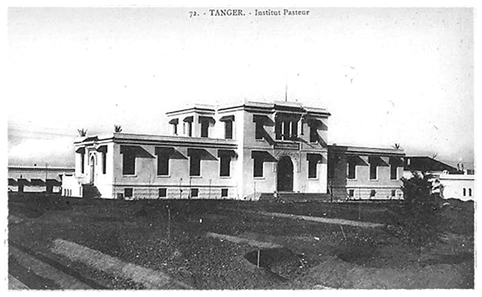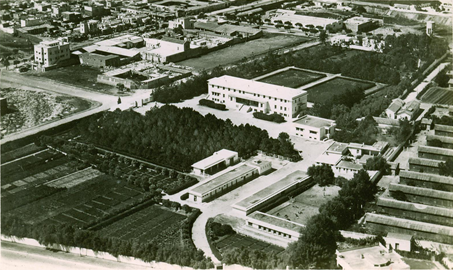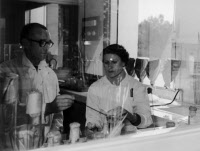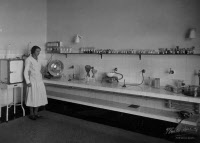History of the Pasteur Institute of Morocco
When in 1906, Mr. Regnault, Minister of France in Tangier envisaged the construction of an institute of hygiene and bacteriology, on land obtained from the Sultan of Morocco, Tangier was the only Moroccan city widely open to foreigners and the seat of the diplomatic representation in Morocco.
The project that culminated in 1910 aimed to provide Morocco with a Pasteur Institute, counterpart of the Pasteur Institute of Tunis and the pastoral establishment of Algeria.
Pasteur Institute of Tangier
 The project of Mr. Regnault, Minister of France in Tangier, to provide Morocco with an institute of hygiene and bacteriology, took shape in 1908, on the occasion of an incident where the sanitary council of Tangier, the diplomatic corps of the time realized that a banal forensic expertise could not be carried out on site for lack of a microscope in the city. The Minister of France then made the Council adopt the principle of the construction of a sanitary establishment.
The project of Mr. Regnault, Minister of France in Tangier, to provide Morocco with an institute of hygiene and bacteriology, took shape in 1908, on the occasion of an incident where the sanitary council of Tangier, the diplomatic corps of the time realized that a banal forensic expertise could not be carried out on site for lack of a microscope in the city. The Minister of France then made the Council adopt the principle of the construction of a sanitary establishment.
The talks with the Sultan of Morocco and the Institut Pasteur, led by the Minister of France, led to the agreement of the parties and the start, in 1910, of a construction financed by the French state and the Institut Pasteur.
A year later, Dr. P. Remlinger, radiologist, former director of the Rabies Institute and the Imperial Institute of Bacteriology in Constantinople, was appointed director. Some practical services began to function in 1912 and, on July 14, 1913, the sanitary institute officially became the Pasteur Institute of Tangier.
The contract between the Pasteur Institute of Paris and the Minister of Foreign Affairs of France was signed on January 1, 1914 and concerns the organization of 3 technical services :
the preparation of rabies and smallpox vaccines, thus ending the importation of vaccines from Algiers or Seville, the vaccination service and the medical and veterinary bacteriological analysis service.
Pasteur Institute of Casablanca
 In 1928, Dr. Roux, sends Edmond Sergent director of the Algerian Pasteur Institute to Rabat to draw up the program of a Moroccan Pasteur Institute, draw up the plans, draft the contract and monitor the construction.
In 1928, Dr. Roux, sends Edmond Sergent director of the Algerian Pasteur Institute to Rabat to draw up the program of a Moroccan Pasteur Institute, draw up the plans, draft the contract and monitor the construction.
The mission lasted three years, and on November 15, 1929, the agreement between the resident general and the Pasteur Institute of Paris was signed. Construction was then able to begin on the land allocated for this purpose, and located between the Military hospital and the civil hospital.
On December 17, the Board of Directors of the Pasteur Institute appointed Dr. George Blanc, director of the Pasteur Institute of Athens for eleven years, as director of the new Pasteur Institute of Morocco. Casablanca was chosen, as the headquarters of the institute, for its population density and its strategic aspects as a major port and head of the railway line. Located in the hospital district, the Pasteur Institute of Casablanca included a main building of 750 m2 with fitted floor and basement, a separate chemistry pavilion, a singery, two horse stables with specialized premises for the preparation of therapeutic serums, pet stores and outbuildings. He was also endowed with a 27-hectare property located in Tit-Mellil a few kilometers from the city and providing part of the food for animals in breeding and experimentation. In addition to the serum service and vaccines, the new Institute includes six laboratories :
general, physics and chemistry, veterinary, rabies, BCG and research.
The Pasteur Institute of Morocco stands out in several ways from the Pasteur Institutes of Tunis and Algeria :
its very stable and almost permanent staff, knows no increase from 1932 to 1956 (five members). He hardly undertakes scientific missions abroad and receives few visitors (Dr. M.Minart, seconded from the IPP on a mission in August 1945). Finally, on the institutional level, it went from five services in 1932 to eight services in 1956. Despite its small size and limited staff, the Institut Pasteur du Maroc is proving to be as active as the other Maghreb Pasteur institutes.
In June 1967, an agreement was concluded between the Pasteur Institute and the Moroccan Government. The Pasteur Institute of Casablanca, called "Center of serums and vaccines" was transformed into a Moroccan public establishment endowed with civil personality and financial autonomy and placed under the administrative supervision of the Ministry of Public Health. In November 1967, the Pasteur Institute transferred the Pasteur Institute of Tangier to Morocco for free. The whole Serum and vaccine Center of Casablanca and the Pasteur Institute of Tangier took the name of the Pasteur Institute of Morocco (royal decree of November 29, 1967). The merger was accompanied by a complete reorganization plan, taking into account both the original vocation of the two institutes and the orientation they had followed over time, but also national imperatives and needs. In Tangier returned a role of hygiene institute for the north of Morocco and a research activity, in liaison with the Institute of Casablanca.
In 1975, financial difficulties led Chabaud to transfer the Tangier Institute to the Moroccan Public Health Services, to which the staff had already been integrated.
Indeed, the two Pasteur institutes of Casablanca and Tangier led an autonomous existence, sometimes competing until 1967 date of Royal Decree N ° 176-66 of June 23, 1967 supplemented by that of November of the same year which gives birth to the Pasteur Institute of Morocco with the grouping of the two Institutes.
The merger was accompanied by a complete reorganization plan, taking into account both the original vocation of the two institutes and the orientation they had followed over time, but also national imperatives and needs.
Pasteur Institute of Morocco
 Robert Néel had taken over the management of the Pasteur Institute in Casablanca in 1962, when Georges Blanc left. But he was very quickly (1963) called to the management of the Pasteur Institute of Algeria and replaced by Marie-Augustin Chabaud. In June 1967, an agreement was concluded between the Pasteur Institute and the Moroccan Government. The Pasteur Institute of Casablanca, called "Center of serums and vaccines" was transformed into a Moroccan public establishment endowed with civil personality and financial autonomy and placed under the administrative supervision of the Ministry of Public Health. In November 1967, the Pasteur Institute transferred the Pasteur Institute of Tangier to Morocco for free. The whole Serum and vaccine Center of Casablanca and the Pasteur Institute of Tangier took the name of the Pasteur Institute of Morocco (royal decree of November 29, 1967). The merger was accompanied by a complete reorganization plan, taking into account both the original vocation of the two institutes and the orientation they had followed over time, but also national imperatives and needs. In Tangier returned a role of hygiene institute for the north of Morocco and a research activity, in liaison with the Institute of Casablanca. In 1975, financial difficulties led Chabaud to transfer the Tangier Institute to the Moroccan Public Health Services, to which the staff had already been integrated. It was henceforth in this framework that the missions of the house continued. If the previous activities (analyzes, rabies vaccination and production) were maintained, the institute gained the Blood Transfusion Center and took a marked orientation of public health: epidemiological investigations and prevention of communicable diseases. Chabaud was replaced in 1977 by a Moroccan director, Abdherraman Alaoui who remained in post until 1983 and who was succeeded by Abdherraman Touhami. At that time, the Pasteur Institute of Morocco was continuing its missions with difficulty, its activities being practically reduced to the production of serums and vaccines and diagnostics. In 1987, Abdellah Benslimane took over the management of the establishment. The following year, he drew up a reorganization plan which was approved by the school's Board of Directors. It provided for productive projects intended to release the resources necessary for the financing of technical-scientific projects. And in fact, thanks to its own resources, but also to subsidies from the State and international cooperation (French and Italian, in particular) and donations from national patrons, the Pasteur Institute of Morocco experienced, in less than ten years, a completely remarkable development. The entire site and its buildings, including the Tit-Mellil farm, were completely renovated. The workforce increased from 101 to 330 people, including 47 researchers. A deep restructuring has organized the activities into large departments. The production of vaccines, serums, culture media and laboratory reagents aims to meet national demand.
Robert Néel had taken over the management of the Pasteur Institute in Casablanca in 1962, when Georges Blanc left. But he was very quickly (1963) called to the management of the Pasteur Institute of Algeria and replaced by Marie-Augustin Chabaud. In June 1967, an agreement was concluded between the Pasteur Institute and the Moroccan Government. The Pasteur Institute of Casablanca, called "Center of serums and vaccines" was transformed into a Moroccan public establishment endowed with civil personality and financial autonomy and placed under the administrative supervision of the Ministry of Public Health. In November 1967, the Pasteur Institute transferred the Pasteur Institute of Tangier to Morocco for free. The whole Serum and vaccine Center of Casablanca and the Pasteur Institute of Tangier took the name of the Pasteur Institute of Morocco (royal decree of November 29, 1967). The merger was accompanied by a complete reorganization plan, taking into account both the original vocation of the two institutes and the orientation they had followed over time, but also national imperatives and needs. In Tangier returned a role of hygiene institute for the north of Morocco and a research activity, in liaison with the Institute of Casablanca. In 1975, financial difficulties led Chabaud to transfer the Tangier Institute to the Moroccan Public Health Services, to which the staff had already been integrated. It was henceforth in this framework that the missions of the house continued. If the previous activities (analyzes, rabies vaccination and production) were maintained, the institute gained the Blood Transfusion Center and took a marked orientation of public health: epidemiological investigations and prevention of communicable diseases. Chabaud was replaced in 1977 by a Moroccan director, Abdherraman Alaoui who remained in post until 1983 and who was succeeded by Abdherraman Touhami. At that time, the Pasteur Institute of Morocco was continuing its missions with difficulty, its activities being practically reduced to the production of serums and vaccines and diagnostics. In 1987, Abdellah Benslimane took over the management of the establishment. The following year, he drew up a reorganization plan which was approved by the school's Board of Directors. It provided for productive projects intended to release the resources necessary for the financing of technical-scientific projects. And in fact, thanks to its own resources, but also to subsidies from the State and international cooperation (French and Italian, in particular) and donations from national patrons, the Pasteur Institute of Morocco experienced, in less than ten years, a completely remarkable development. The entire site and its buildings, including the Tit-Mellil farm, were completely renovated. The workforce increased from 101 to 330 people, including 47 researchers. A deep restructuring has organized the activities into large departments. The production of vaccines, serums, culture media and laboratory reagents aims to meet national demand.
 The pharmaceutical and biological control department includes laboratories for the control of serums, solvents, biological and hemoderivated reagents, cosmetics, water and the environment, food hygiene. Public health activities, grouped in a medical department, include rabies treatment, international vaccinations, surveillance of sexually transmitted diseases, AIDS screening. Research activities have diversified, both at the fundamental and applied levels. The Research Department carries out epidemiological surveillance of AIDS, hepatitis, cancer of the rectum, cancer of the ENT sphere the most frequent in Morocco, cryptosporidiosis, Leishmaniasis, resistance of the Koch bacillus. On a fundamental level, the research themes favor the genotyping and the molecular characterization of retroviruses, hepatitis viruses, Koch's bacillus, the structural study of the different antimicrobial and antiparasitic fractions of snake venoms. A human genetics unit, created in 1995, focuses its work on the genetic support of hemoglobinopathies, fragile X syndrome and Bloom's disease.
The pharmaceutical and biological control department includes laboratories for the control of serums, solvents, biological and hemoderivated reagents, cosmetics, water and the environment, food hygiene. Public health activities, grouped in a medical department, include rabies treatment, international vaccinations, surveillance of sexually transmitted diseases, AIDS screening. Research activities have diversified, both at the fundamental and applied levels. The Research Department carries out epidemiological surveillance of AIDS, hepatitis, cancer of the rectum, cancer of the ENT sphere the most frequent in Morocco, cryptosporidiosis, Leishmaniasis, resistance of the Koch bacillus. On a fundamental level, the research themes favor the genotyping and the molecular characterization of retroviruses, hepatitis viruses, Koch's bacillus, the structural study of the different antimicrobial and antiparasitic fractions of snake venoms. A human genetics unit, created in 1995, focuses its work on the genetic support of hemoglobinopathies, fragile X syndrome and Bloom's disease.
References
Marie-Paule Laberge The Pasteur Institutes of the Maghreb: Medical scientific research within the framework of colonial policy. French Journal of Overseas History, T. LXXIV, 1987, n° 274, pp27- 42. Jean-Pierre Dedet The Overseas Pasteur Institutes: One hundred and twenty years of French microbiology in the world Edition: L'Harmattan, 2001